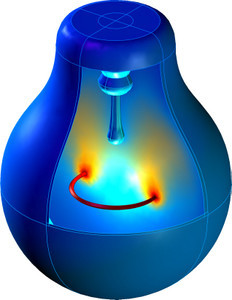
When it gets dark, you flick on the lights. If you were to model this simple example, you would need to take all forms of heat transfer within consideration; convection, conduction, and radiation are all at play when a light bulb is flicked on.
Modeling a Light Bulb
The example used to show how to model heat transfer in a recent webinar involved modeling the natural convection flow with heat in a light bulb. It was a particularly good problem to work through, as modeling a light bulb requires taking all three forms of heat transfer into account, as well as flow.
All Three Forms of Heat Transfer
First, you have conduction, when a 60 W filament is heated thus transferring heat from the heat source to the light bulb. Then there’s convection, which drives a flow inside the bulb transferring the heat from the filament throughout the bulb via the movement of fluids (in this case that’s argon gas). Finally, there is the radiation portion of the problem, and in this case that includes surface-to-surface and surface-to-ambient radiation.
OurHeat Transfer Module includes both of these types of radiation, so that you can account for shading and reflections between radiating surfaces, as well as ambient radiation that may be fixed or given by an arbitrary function. What makes this a multiphysics problem, and not “just” a heat transfer example, is of course the fact that the light bulb involves both heat transfer and fluid flow.
Below is a model of a light bulb where you can see the temperature distribution on the outside of the bulb and the distribution of temperature and pressure inside the bulb:

Free convection in a light bulb.
This example of natural convection in a light bulb is worked through step-by-step in theFree Convection in a Light Bulb modelin our Model Gallery.
It’s a multiphysics world, and our software caters to engineers looking to model real-world applications.



Comments (6)
Thomas Müller
October 8, 2012Very nice example. It combines several heat transfer mechanisms. Unfortunately, following the instructions (for version 4.2a) in the Model Gallery the simulation does not work.
Fanny Griesmer
October 12, 2012 COMSOL EmployeeThe instructions should work for v4.2a as well. If you are having trouble, feel free to send an email tosupport@comsol.comfor help.
abdennaceur karoui
September 1, 2013The webinar is no longer available through the provided link ” archived Heat Transfer webinar”.
Is there another way to access to that talk ?
AK
Fanny Griesmer
September 5, 2013 COMSOL EmployeeHi,
We have since run another webinar on a similar topic, where you can learn more about the light bulb problem. While it is not the main demo of the webinar, you may still find it useful:http://www.comsol.com/events/1243/heat-radiation-simulations/
Eric Sevilla
October 9, 2020Is there a way to couple this simulation to simulate the irradiation outside of the light-bulb?
Enza P.
November 4, 2020Hi Eric, I have the same proble, I would like to simulate the irradiation outside a bulb or a fluorescent lamp but I did not find useful simulation,
do you have useful advice ?
thanks